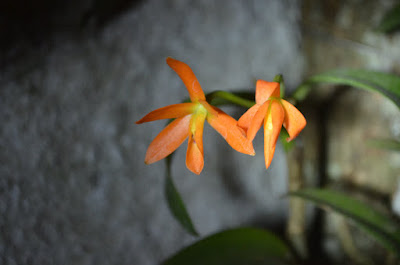Guarianthe aurantiaca is native to Mexico, Guatemala, El Salvador, Honduras and Nicaragua. In Nicaragua, the plants grow on trees on dry hilly pastures and in forests near roads...
Guarianthe aurantiaca also called as Orange Guarianthe, Epidendrum aurantiacum, Cattleya aurantiaca, Laelia aurantiaca, Broughtonia aurea, Epidendrum aureum, is a species of the genus Guarianthe. This species was described by Robert Louis Dressler & Wesley Ervin Higgins in 2003.
IDENTIFY GUARIANTHE AURANTIACA
Guarianthe aurantiaca is native to Mexico, Guatemala, El Salvador, Honduras and Nicaragua. In Nicaragua, the plants grow on trees on dry hilly pastures and in forests near roads. In the vicinity of Matagalpa and Managua, they are found at an altitude of 600-1000 m. In Mexico, they grow on trees growing on the sheltered slopes of the hills and ridge valleys in the Pacific region at an altitude of 300-1100 m. The natural environment of this plant extends from the state of Sinaloa to the south until borders with Guatemala.
It is a stout, small to medium sized, hot to cool growing epiphytic and occasional lithophytic species, which growing up to 38 cm in height, with cylindric-fusiform, lightly compressed, 15-20 cm long pseudobulbs carrying 2, apical, coriaceous, fleshy, elliptic to oblong-lanceolate, 18 cm long and 5 cm wide leaves with a rounded, retuse apex.
Orange Guarianthe flowers from late winter through spring on a terminal, 16 cm long, 2 to 11 flowered, umbelliform inflorescence arising on a mature pseudobulb. The flowers have a diameter of 2.5-3.8 cm and usually last about 2 weeks. They are odorless. The outer and inner whorls are almost the same size and shape, and the inner whorl flakes have a tendency to bend forward. As a result, the flowers do not open completely and it happens that some of the clones self-pollinate without opening. The spotted lip is almost the same size and shape as the petals of the outer and inner whorls. The lip has no lateral lobes. Its banks at the base curve upwards towards a partially hidden spine, which is characteristic of all representatives of Cattleya species found in Central America. The color of the flower can be differentiated from yellow or yellow-orange to deep red-orange with red or purple veins running from the throat to the half-length of the mottled lip. Some populations in the wild are self-pollinating.
GUARIANTHE AURANTIACA CARE AND CULTURE
Cultural information should only be used as a guide, and should be to be adapted to suit you. Your physical location; where you grow your plants, how much time you have to devote to their care, and many other factors, will need to be taken into account. Only then can you decide on the cultural methods that best suit you and your plants.
Light:
Guarianthe aurantiaca needs a light level of 25000-35000 lux. Strong air movement should be ensured all the time.
Temperature:
It is a plant with moderate thermal requirements. The average summer temperature in the summer is 26-27 ° C, and at night 15 ° C, with a daily amplitude of 12 ° C. In spring, the average day temperature is then 28-29 ° C, at night 14-16 ° C, with a daily amplitude of 13-15 ° C. On very warm winter days average temperatures are 27-28 ° C, average temperatures at night 12-13 ° C, with an amplitude of daily fluctuations of 15-16 ° C.
Humidity:
Orange Guarianthe needs the humidity of 75-85% from late spring to late autumn, drops to about 65% in late winter.
Substrate, growing media and repotting:
For Guarianthe aurantiaca, you can use small pots or baskets can be filled with a very thick, loose, fast-drying substrate that allows the roots to dry quickly after watering. It is recommended to use smaller pots sufficient for 1-2 years growth, because the substrate in larger pots stays wet for too long after watering. The result of insufficient quick-drying roots can be their rotting. You can use of thick bark or cork pieces mixed with large lumps of charcoal.
These plants can also be mounted on tree-trunks or cork, but because they should be provided with high humidity throughout the year, they must be watered at least once a day during the summer. In the case of such suspended plants, during the dry and hot periods it may be necessary to water several times a day.
Repotting or dividing plants should be done when the growth of new roots begins. This allows the plants to acclimatize in a relatively short time and provides them with the least stress. In the event of violation at the wrong time, many of the 2-branched keikis will remain stagnant and eventually die.
Watering:
Rainfall is very abundant from late spring to autumn, then in the winter they go through the dry season. The cultivated plants should be watered strongly during the full growth, but the roots must always dry quickly after watering. When new growths reach maturity in the autumn, the amount of water should be reduced.
Fertilizer:
The plants should be fertilized every week 1/4-1/2 of the recommended dose of fertilizer for orchids. A fertilizer with a high nitrogen content is beneficial from spring to mid-summer, and a fertilizer richer in phosphorus should be used in late summer and autumn.
Rest period:
In winter, watering for Guarianthe aurantiaca should be limited, but must not be allowed to stay dry for a long time. The plants growing on bark pieces must be lightly sprinkled every 3-5 days, and growing in containers should be watered every 2-4 weeks. The frequency of watering should vary depending on the ambient conditions - the right temperature, humidity, air movement, light intensity, the size of the pot and the type of substrate are important. Fertilization should be limited or should be completely abandoned until spring, when stronger watering resumes.















COMMENTS